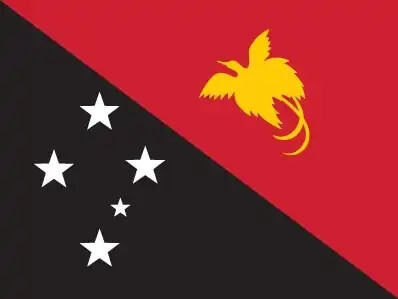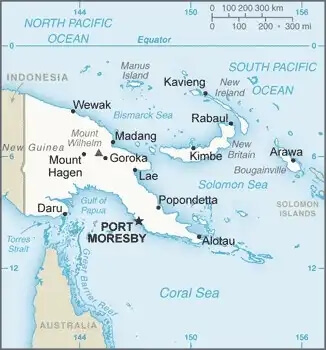World Book
Papua New Guinea
Introduction
Background
The eastern half of the island of New Guinea was divided between Germany (north) and the UK (south) in 1885. The latter area was transferred to Australia in 1902, which occupied the northern portion during World War I and continued to administer the combined areas until independence in 1975. Since 2001, the island of Bougainville has had autonomy, with many national powers devolved to the region.
Geography
Area
total : 462,840 sq km
land: 452,860 sq km
water: 9,980 sq km
Climate
tropical; northwest monsoon (December to March), southeast monsoon (May to October); slight seasonal temperature variation
Natural resources
gold, copper, silver, natural gas, timber, oil, fisheries
People and Society
Population
total: 10,046,233 (2024 est.)
Ethnic groups
Melanesian, Papuan, Negrito, Micronesian, Polynesian
Languages
Tok Pisin (official), English (official), Hiri Motu (official), some 839 living indigenous languages are spoken (about 12% of the world's total)
Religions
Protestant 64.3% (Evangelical Lutheran 18.4%, Seventh Day Adventist 12.9%, Pentecostal 10.4%, United Church 10.3%, Evangelical Alliance 5.9%, Anglican 3.2%, Baptist 2.8%, Salvation Army 0.4%), Roman Catholic 26%, other Christian 5.3%, non-Christian 1.4%, unspecified 3.1% (2011 est.)
Population growth rate
2.26% (2024 est.)
Government
Government type
parliamentary democracy under a constitutional monarchy; a Commonwealth realm
Capital
name: Port Moresby
Executive branch
chief of state: King CHARLES III (since 8 September 2022); represented by Governor General Grand Chief Sir Bob DADAE (since 28 February 2017)
head of government: Prime Minister James MARAPE (since 30 May 2019)
Diplomatic representation in the US
chief of mission: Ambassador Arnold Karibone AMET (since 5 September 2025)
Diplomatic representation from the US
chief of mission: Ambassador Ann Marie YASTISHOCK (since 22 February 2024); note - also accredited to the Solomon Islands and Vanuatu
Economy
Economic overview
lower-middle-income Pacific island economy; primarily informal agrarian sector; natural-resource-rich and key exporter of liquified natural gas; collapse in betel nut prices, tighter monetary policy, and improved foreign-exchange availability contributing to declining inflation; challenges include lack of progress in infrastructure, agricultural reform, and corruption
Real GDP (purchasing power parity)
$45.487 billion (2024 est.)
$43.697 billion (2023 est.)
$42.093 billion (2022 est.)
Real GDP per capita
$4,300 (2024 est.)
$4,200 (2023 est.)
$4,100 (2022 est.)
Exports
$12.93 billion (2023 est.)
$14.862 billion (2022 est.)
$11.032 billion (2021 est.)
Exports - partners
China 28%, Japan 25%, Australia 17%, Taiwan 8%, India 4% (2023)
Exports - commodities
natural gas, gold, copper ore, palm oil, nickel (2023)
Imports
$7.192 billion (2023 est.)
$8.568 billion (2022 est.)
$6.43 billion (2021 est.)
Imports - partners
Australia 27%, China 24%, Singapore 15%, Malaysia 9%, Japan 4% (2023)
Imports - commodities
refined petroleum, trucks, rice, plastic products, excavation machinery (2023)
Human Development Index
The country's Human Development Index (HDI) is 0.576, ranking it 160th out of 193 countries tested. (more information)



